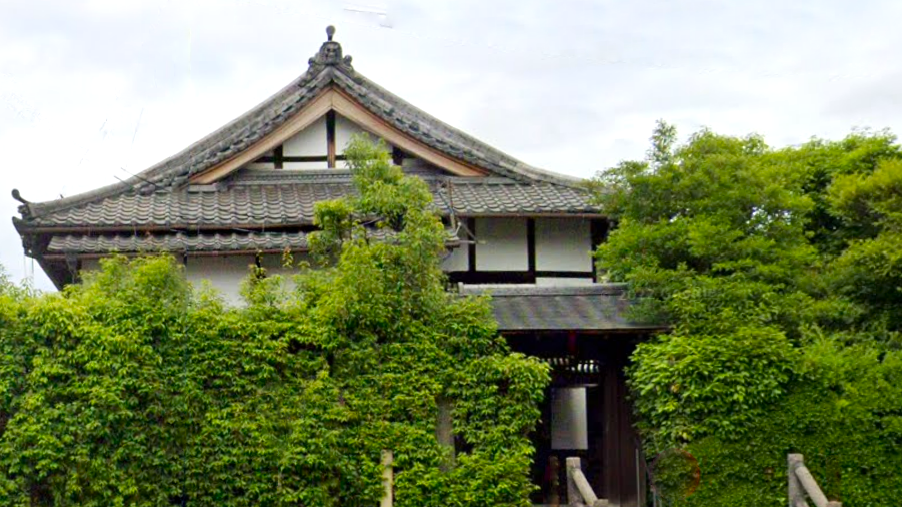Introduced to the Kamakura shogunate by the Zen monk Yosai, tea flourished at the beginning of tea culture among warlords as a form of spiritual training, closely associated with Zen philosophy. In addition to its medical benefits, tea offered soothing comfort to the hearts of warlords facing the ever-present specter of death. Tea became a political tool during the Warring States period (1467-1590) of Oda Nobunaga and Toyotomi Hideyoshi. This tradition produced several treasures and created countless historical stories. Even today, chanoyu (the way of tea) continues to captivate a diverse range of enthusiasts.
Three Great Tea Masters in Japan
Sen-no-Rikyu (merchant)

@ Sakai City Museum
Sen-no-Rikyu (1522-1591, 千利休) is widely regarded as the tea master of Oda Nobunaga and Toyotomi Hideyoshi. Rikyu was an innovator and also the perfectionist of Wabi-cha, emphasizing simplicity and removing unnecessary artificial elements to focus on the inherent spirituality of nature. After unifying the nation, Hideyoshi forced Rikyu to commit suicide. >> Read More
Furuta Oribe (samurai)

@Wikimedia(*)
The samurai Furuta Oribe (1543-1615, 古田織部), who fought in numerous battles during the Warring States period, created the Oribe school of the way of tea. The Oribe school emphasizes the importance of cleanliness, placing tea bowls on trays instead of directly on the tatami mats, and never passing bowls around. The Oribe school won the hearts of Tokugawa shoguns such as Ieyasu and Hidetada, as well as many feudal lords.
In contrast to his master Sen-no-Rikyu's Wabi-cha, Oribe sought the beauty in motion, called "Heugemono"(one who jokes, jests, etc.), the hallmark of his style.
Kobori Enshu (samurai)
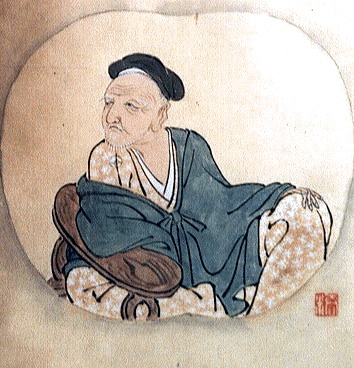
@ Wikimedia(*)
Kobori Ensyu (1579-1647, 小堀遠州) was a feudal lord and tea master in the early Edo period and an instructor of the tea ceremony to the Tokugawa shoguns. He held more than 400 tea ceremonies during his lifetime. In addition, he was a central figure in the Kanei cultural salons led by Emperor Gomizunoo. He created the way of "Kireisabi", which infused the spirit of chanoyu with beauty and brightness, adapting the art of chanoyu to respond to the expectations of daimyo (feudal lord) in his time. The multitalented Enshu showcased prowess in both construction and landscaping at several iconic sites, including the Katsura Imperial Villa, Kyoto Sento Imperial Palace, Nijo-jo Castle, Nagoya Castle, and more, as Sakuji Bugyo (commissioner of building) within the Tokugawa Shogunate, as well.
Renowned Samurai Tea Masters
Urakusai (Oda Nagamasu)
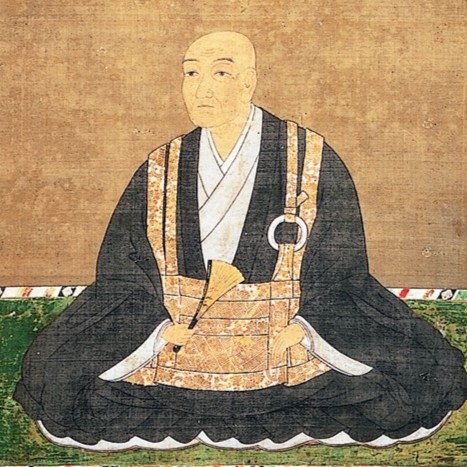
@shoden-eigen-in
Urakusai, known as Oda Nagamasu (1548-1622, 有楽斎), a younger brother of a powerful Samurai, Oda Nobunaga, lived a long life to the age of 75 despite the turbulent Warring States Period. His principle of the tea ceremony was 'entertaining the guests'. After fighting on the battlefield many times, this would be his enlightenment by serving the most powerful warlords, Oda Nobunaga, Toyotomi Hideyoshi, and Tokugawa Ieyasu. Urakusai was a talented tea master whom even Rikyu gave due respect. >> Read More
Matsudaira Harusato, known as Fumai

Around the end of the 19th century, the 7th lord, Matsudaira Harusato (1751-1818, 松平治郷), reformed the domain's duties, including financial reconstruction and the promotion of new local industries. Harusato was also a highly cultured individual, especially in the tea ceremony. His way was called the Fumai School, meaning ‘not to be blinded by material desires.’ He pursued the purity and simplicity in his tea style, returning to principles established by Sen-no-Rikyu. In keeping with the refined atmosphere of the tea ceremony, Japanese sweets were created to express the elegance of each season. >> Read More
National Treasure-designated Teahouses
Joan in Inuyama / Urakusai
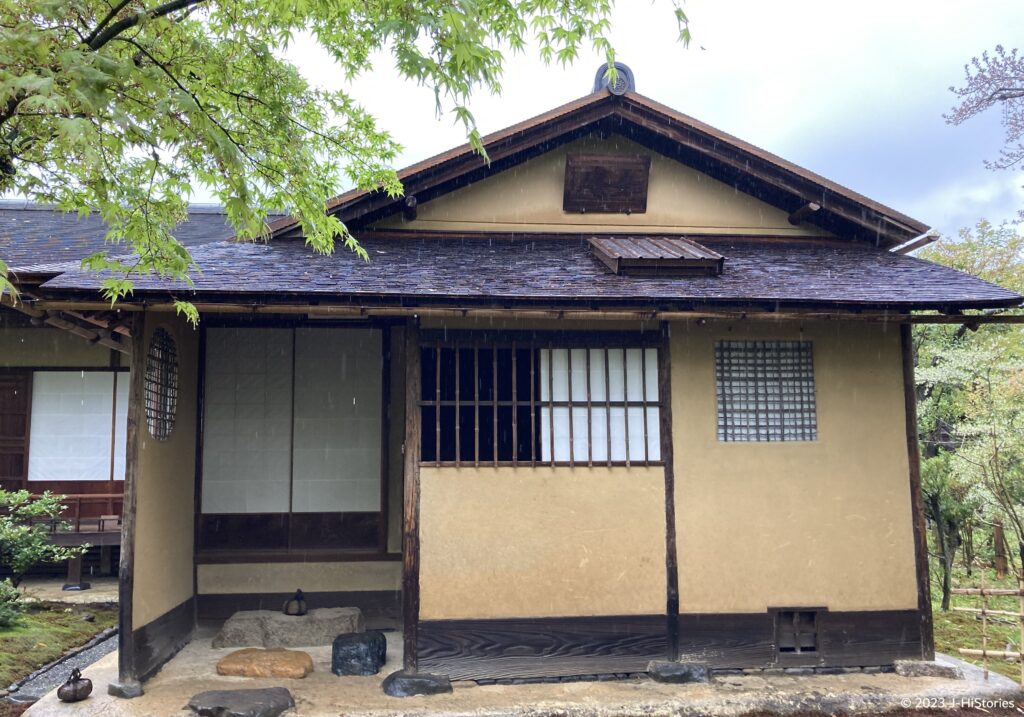
The Joan consists of two tatami mats for guests, nearly one tatami mat for a tea master, and a Tokonoma (alcove). Notable features include (1) a triangular floor that connects the master's door and the guest space, and (2) the wallboard next to the "furo" (furnace) is hollowed out and supported by the cedar pillar at the corner of the fireplace. This creates a non-cramped atmosphere to entertain guests. Joan is the only National Treasure-designated teahouse that you can visit anytime and enjoy tea. >> Read More
Taian in Kyoto / Sen-no-Rikyu
The Taian Teahouse is located in Myokian Temple. Rikyu ingeniously downsized Taian to a mere two tatami mats, half the size of the conventional space. The natural light creates the room's ambiance through the windows, the use of earthen walls concealing the pillars, and a suspended ceiling. This artful approach created an illusion of spaciousness within the confined room. Inside the Tokonoma alcove, Rikyu masterfully conveyed the essence of wabi aesthetics through simple flower vases and hanging scrolls. Reservations must be made by return postcard with Myokian at least one month before the desired date of the visit. >> Read More
Mittan in Kyoto / Kobori Enshu
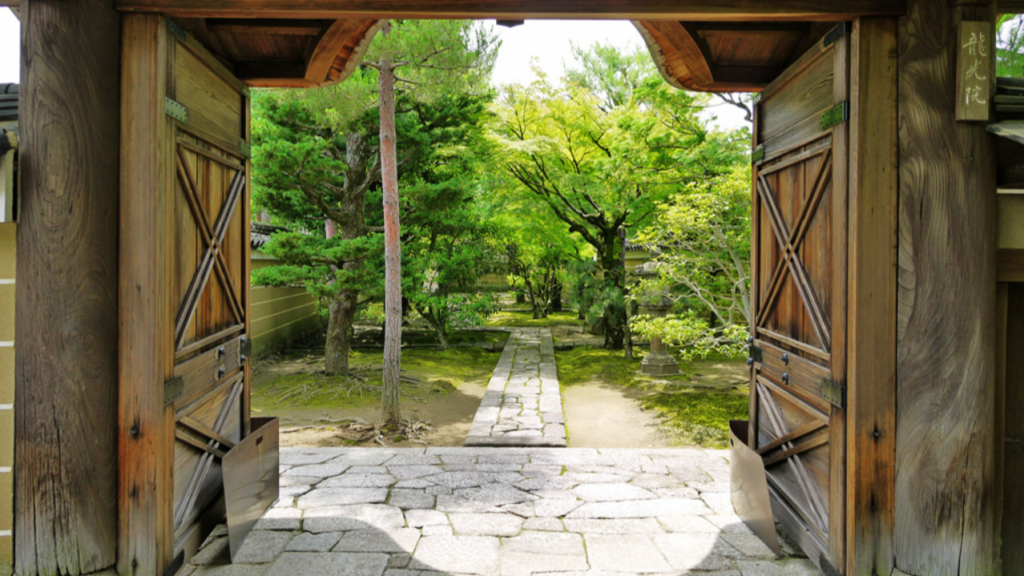
(Source: 京都フリー写真素材集)
Mittan teahouse, located at the Ryukoin sub-temple of Daitokuji Temple, is a four-and-a-half tatami mat teahouse that combines the shoin and sukiya-zukuri styles. Unfortunately, it is closed to the public, so visitors cannot see it. However, another tea room, "Bozen" at the Kohoan sub-temple of Daitokuji Temple, created by Kobori Enshu, is sometimes open to the public. It has a unique entrance – the lower part of the front paper screen is open, letting guests enter from beneath, a twist on the traditional Nijiriguchi (crawling entrance). As you step inside and look back, the view reveals itself: the lush trees and black pebble path through the lower shoji door. It's one of the fine works of Enshu.
Outstanding Golden Tea Room
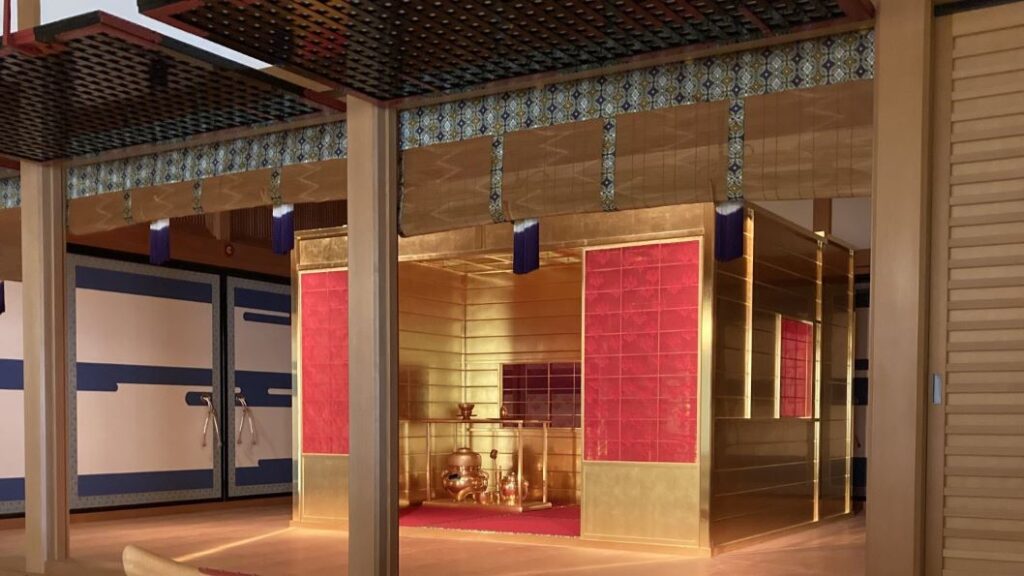
The walls, pillars, ceiling, and tea utensils covered in gold leaf reflect a solemn scarlet color in the Golden Tea Room through the scarlet woolen cloth on the Shoji screen. The portable Golden Tea House was constructed by Toyotomi Hideyoshi. It was used at the Kyoto Imperial Palace and Nagoya Castle in Saga prefecture, serving as venues for an elaborate Tea Ceremony. It created a royal atmosphere with the gold leaf in the tea room. >> Read More
The History of Chanoyu (The Way of Tea)
In the early Kamakura period (1185-1333), Yosai/Eisai, a Zen monk and founder of the Rinzai school of Zen Buddhism, discovered the wonders of tea in the Song Dynasty, where he was studying. As soon as he presented tea to Minamoto Sanetomo, the third shogun of the Kamakura Shogunate, "Sarei" (Zen-style tea ceremony), a ritual of drinking tea and spiritual concentration, spread among the samurai of Kamakura, along with Zen Buddhism. In time, Ashikaga Yoshimitsu, the third shogun of the Muromachi Shogunate (the founder of Kinkakuji Temple), promoted trade with the Sung Dynasty, and the Shogunate's Karamono officers collected selected Sung tea goods.
On the other hand, the original form of "Wabicha," which aimed at "spiritual richness," was promoted by Murata Juko, and later, Sen-no-Rikyu brought the tea ceremony to a heightened level of spirituality. During the Warring States Period, which began with the Onin War, the Ashikaga shoguns' collections were scattered and lost. These were acquired by wealthy merchants in Sakai city, such as Rikyu. They cultivated friendships with rising federal lords through the trade in guns and gunpowder, and "tea ceremonies" with these collections.
Possession of tea utensils took on political significance when the samurai, Matsunaga Hisahide, presented Oda Nobunaga with the "Tsukumo Nasu" tea caddy, which had been passed down from Shogun Yoshimitsu to generations of shoguns of the Muromachi Shogunate. Oda Nobunaga found value in the history of famous tea utensils and bestowed the gathered tea utensils upon warlords who had distinguished themselves in the land's battles, granting them the privilege of hosting tea ceremonies with these prized implements. A merchant hailing from Sakai City, Sen-no-Rikyu, identified the exceptional quality of these tea utensils. As a result, these tea implements expressed glory for the warlords, while Nobunaga cleverly employed them to secure the allegiance of people's hearts and minds. But many of them were burned to ashes in the Honnoji incident in 1582.
Toyotomi Hideyoshi, who succeeded Nobunaga, continued to place great importance on Rikyu, and the teahouse became a place of spiritual unification for warlords who spent their days facing death, as well as a secret room for political meetings. It was obvious that a rift would develop between Rikyu, who pursued Wabicha according to his logic, and Hideyoshi, who was willing to have anyone bow down to him as the ruler of the country. Eventually, Rikyu was ordered to commit suicide and died.
Later, Furuta Oribe, one of Rikyu's seven leading disciples, became the tea master of Tokugawa Ieyasu (the first shogun of the Tokugawa Shogunate) and the tea coach of Tokugawa Hidetada (the second shogun), creating a samurai-style of tea ceremony suitable for Samurai. Distinct from the Wabicha of Rikyu, the Oribe school pursued "beauty in motion" and liberated the Japanese mind to find beauty in things. Inevitably, the tea ceremony was held in a spacious place, not in a small room with two and a half tatami mats. Oribe, however, was suspected of informing on the side of Toyotomi, Tokugawa's enemy, and was ordered by Ieyasu to commit suicide. Since the feudal lords officially promoted the tea ceremony, it flourished throughout the Edo period (1603-1867), with a wide range of styles in each clan.
In turbulent times, the tea masters created the Japanese way of tea with their insight while confronting the powers that be. Among them, Urakusai served Nobunaga, Hideyoshi, and Ieyasu, and created the tea way to entertain people.

